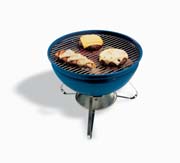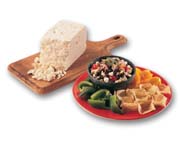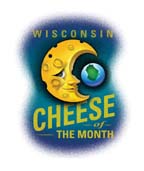
Artisan and farmstead cheeses, in particular, are a star attraction as American consumers continue to become increasingly food savvy. Artisan cheeses are produced by hand in small quantities in a manner that respects the tradition of the cheese. Farmstead cheeses are made using only milk from the herd on the farm where the cheese is made.
Artisan and farmstead cheeses, as well as some unique ethnic cheeses, are often referred to as specialty cheeses. The growth in specialty cheeses has been fueled by the rise of regional cuisine in which chefs are creating menus emphasizing the finest local foods, according to the California Milk Advisory Board (CMAB). It is also due to increased sophistication of the consumer palate, which is prompting specialty food stores to expand their cheese selections.
The Wisconsin Milk Marketing Board (WMMB) has identified numerous cheese-friendly food trends that promise to keep the segment sizzling well into 2005. The list includes, first, and foremost, the increasingly popular low-carbohydrate diet. With just 1g of carbohydrates or less per ounce of most cheese varieties, cheese brings creamy textures and rich, diverse flavors to high-protein dishes. It's also a great low-carb stand-alone snack for the more than 10 million Americans who now say they're adopting a low-carb lifestyle.
Almost always in style, comfort foods remain on the "what's hot" list for good reason-these dishes make us feel good. Today, however, flavor-seeking Americans crave comfort foods with added pizzazz-and that's where the cheese comes in. Macaroni and cheese can be jazzed up with flavorful three- or four-cheese blends and nontraditional varieties. Mashed potatoes get added appetite appeal with the simple addition of shredded cheeses such as white Cheddar, Gruyere, Parmesan and Gorgonzola.
Like comfort foods, convenience is a trend that continues on an upward trajectory. The delicious part is that the concept has expanded well beyond the realm of American sandwich singles and string cheese. Interesting ready-to-use shredded blends are popular, as are ethnic-style cheese blends. Furthermore, consumers are learning to appreciate the convenience of natural cheese spreads and specialty cheeses in pre-sliced, sandwich- and entertaining-ready forms.
Indeed, sandwiches have undergone a remarkable transformation in recent years. Today you can find creamy fresh mozzarella, smoked Cheddar, piquant aged Provolone, Asiago, feta, brie, Muenster and robust Gorgonzola in between two slices of bread. Chefs and restaurateurs have discovered that using specialty cheeses instantly turns an ordinary, traditional sandwich into a specialty, signature item. Consumers are taking the same approach at home. Sandwich night is now something to look forward to.

Cheese knows no borders
Ethnic cheeses today are more than grated Parmesan. The most prominent ethnic cheese category by far continues to be Italian; however, other ethnic cheese segments are coming on strong as well, particularly Hispanic-style varieties.California is the country's leading producer of Hispanic-style cheeses, and in 2003 produced 82.3 million pounds, according to CMAB. The state currently produces more than 25 types and forms of Hispanic-style cheese. Just a decade ago, these cheeses were difficult to find in mainstream grocery stores. Consumers had to make a trip to a Mexican specialty store. This is no longer the case.
Hispanic-style cheeses fall into two general categories-fresh and aged. Fresh, also called unripened cheeses, are very young cheeses that have not been allowed to age. They are typically soft and moist, white or off-white in color and taste like fresh milk. Like milk, these fresh cheeses must be refrigerated, and they also expire like milk. A special characteristic of many Hispanic-style fresh cheeses is that they hold their shape during cooking. When heated, they typically soften but do not melt or flow.
Aged Hispanic-style cheeses are semi-firm to firm. A few of them will soften but not melt or flow when heated. Others will melt for a rich creamy texture and taste. Aged cheeses must also be refrigerated; however, unlike fresh cheeses, aged cheeses have a much longer shelflife.
Other trends to note
Though still a relatively small niche, organic dairy products, including cheeses, are among the fastest growing food categories. Consumer demand for products perceived to be healthful and natural is fueling the trend, as is cheesemaker and dairy producer interest in reaping the often significantly higher margins that organic products command.When dining out, the cheese course has become a delicious and unique ending to a meal. Introduced via upscale restaurants during the past several years, the cheese course has expanded beyond the confines of fine dining into casual dining and home entertaining, as well. Taking the concept a step further is the idea of the cheese flight. Specifically, flights feature cheeses of
the same variety or family, but of different ages, of different milk types, of different regions, etc. They showcase a variety of flavors, textures and product styles within one specific type or variety of cheese. In addition to Cheddar, popular cheeses to showcase in flights include blues, soft-ripened cheeses and mixed-milk cheeses.
Cheese flights also often focus on very flavorful cheeses, such as washed rind cheeses. From Gruyere and Fontina, to brick and Muenster, these classics are being discovered and appreciated by a wider-than-ever audience. And, innovative new variations are featuring rinds washed and rubbed with flavorful ingredients such as cocoa, cinnamon, smoked paprika, cumin and coriander.
Many cheesemakers are also taking natural cheese favorites and giving them exciting new flavor profiles. Havarti, for instance, is kicked up with horseradish and chives; Cheddar is spiked with Pinot Grigio or Shiraz wine; and smoked Gouda is enhanced with garlic.
And lastly, the true dessert cheese-mascarpone-is emerging as a favorite ingredient for adding creamy, fresh-tasting richness to everything from soups and appetizers, to sauces and French toast.
To get an idea of some of the new cheeses introduced recently that complement these trends, check out page 86.

Sidebar: Cheese-of-the-month Program
In July, WMMB began giving consumers a reason to shop, stop and taste the cheese-special varieties that is-with its new Wisconsin Cheese of the Month program. The program kicked off in participating cheese specialty stores and departments across Wisconsin. It is designed to acquaint Wisconsin residents with some of the state's more interesting but unfamiliar cheese varieties. Each month, participating stores receive merchandising materials featuring two special Wisconsin cheeses. Stores then choose to feature one of these cheeses-supported by in-store sampling, deli case signage and special cheese-of-the-month cards containing basic cheese and pairing information, as well as a new consumer-friendly recipe. The program began by featuring feta and aged Cheddar."The Wisconsin Cheese of the Month program is the first of its kind designed to focus on the special cheese varieties crafted in Wisconsin and available to Wisconsin residents through cheese specialty stores and cheese departments," says Dave Bavlnka, v.p. marketing, fluid and related products for WMMB.
For more information about the program, including a list of participating cheese specialty stores, monthly recipes and photos, visit www.wisdairy.com.